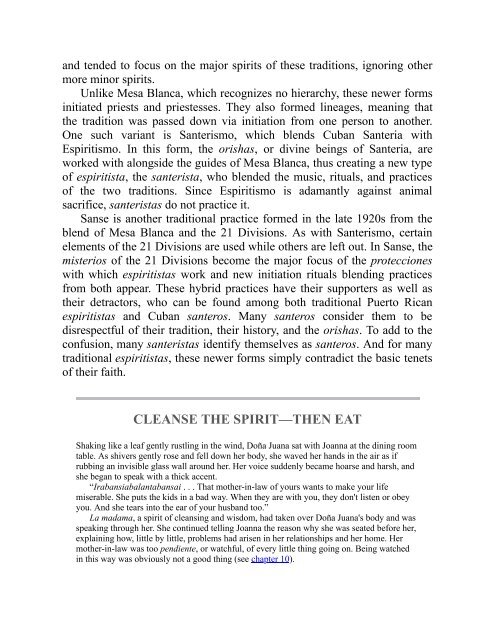Create successful ePaper yourself
Turn your PDF publications into a flip-book with our unique Google optimized e-Paper software.
and tended to focus on the major spirits of these traditions, ignoring other<br />
more minor spirits.<br />
Unlike Mesa Blanca, which recognizes no hierarchy, these newer forms<br />
initiated priests and priestesses. They also formed lineages, meaning that<br />
the tradition was passed down via initiation from one person to another.<br />
One such variant is Santerismo, which blends Cuban Santeria with<br />
<strong>Espiritismo</strong>. In this form, the orishas, or divine beings of Santeria, are<br />
worked with alongside the guides of Mesa Blanca, thus creating a new type<br />
of espiritista, the santerista, who blended the music, rituals, and practices<br />
of the two traditions. Since <strong>Espiritismo</strong> is adamantly against animal<br />
sacrifice, santeristas do not practice it.<br />
Sanse is another traditional practice formed in the late 1920s from the<br />
blend of Mesa Blanca and the 21 Divisions. As with Santerismo, certain<br />
elements of the 21 Divisions are used while others are left out. In Sanse, the<br />
misterios of the 21 Divisions become the major focus of the protecciones<br />
with which espiritistas work and new initiation rituals blending practices<br />
from both appear. These hybrid practices have their supporters as well as<br />
their detractors, who can be found among both traditional <strong>Puerto</strong> <strong>Rican</strong><br />
espiritistas and Cuban santeros. Many santeros consider them to be<br />
disrespectful of their tradition, their history, and the orishas. To add to the<br />
confusion, many santeristas identify themselves as santeros. And for many<br />
traditional espiritistas, these newer forms simply contradict the basic tenets<br />
of their faith.<br />
CLEANSE THE SPIRIT—THEN EAT<br />
Shaking like a leaf gently rustling in the wind, Doña Juana sat with Joanna at the dining room<br />
table. As shivers gently rose and fell down her body, she waved her hands in the air as if<br />
rubbing an invisible glass wall around her. Her voice suddenly became hoarse and harsh, and<br />
she began to speak with a thick accent.<br />
“Irabansiabalantabansai . . . That mother-in-law of yours wants to make your life<br />
miserable. She puts the kids in a bad way. When they are with you, they don't listen or obey<br />
you. And she tears into the ear of your husband too.”<br />
La madama, a spirit of cleansing and wisdom, had taken over Doña Juana's body and was<br />
speaking through her. She continued telling Joanna the reason why she was seated before her,<br />
explaining how, little by little, problems had arisen in her relationships and her home. Her<br />
mother-in-law was too pendiente, or watchful, of every little thing going on. Being watched<br />
in this way was obviously not a good thing (see chapter 10).


















